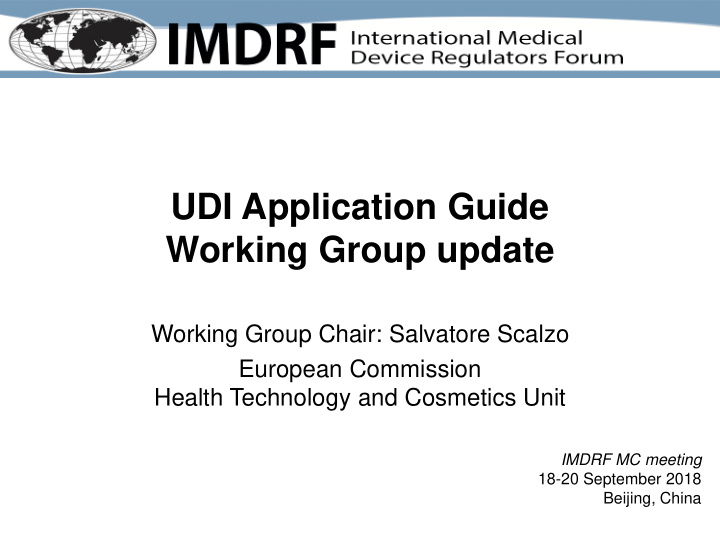



UDI Application Guide Working Group update Working Group Chair: Salvatore Scalzo European Commission Health Technology and Cosmetics Unit IMDRF MC meeting 18-20 September 2018 Beijing, China
The Working Group It is chaired by the EU and includes representatives from: -All IMDRF MC countries (European Union – Chair -, Australia, Brazil, Canada, China, Japan, Russian Federation, Singapore, South Korea, United States) -World Health Organisation (WHO) -Global industry associations GMTA and DITTA 2
Background and scope of the project • Work Item adopted at the IMDRF-12 meeting in Ottawa (September 2017), based on a GMTA proposal • Purpose: To promote a globally harmonized approach to the application of a UDI system in support of the IMDRF UDI Guidance Document (IMDRF/WG UDI/N7Final:2013) • Scope of the work Responsibilities for establishing and maintaining a UDI General UDI assignment rules Considerations related to placement of UDI on all packaging levels, on package labelling and on the device itself Use of UDI in forms and databases Considerations related to submission of UDI core data elements to UDI databases General principles for good implementation of a UDI system (transition to UDI system and feasibility issues for UDI marking) • General principles of a good UDI-Database design • Based on a preliminary working draft of the UDI Application Guide provided by the GMTA industry for review and edit by the IMDRF UDI Work Group 3
State-of-play • F2F meeting of the WG took place in Brussels on 12-15 February 2018 • The WG produced 3 draft documents • A main UDI Application Guide • An information document mapping the use/specifications of UDI data elements in different jurisdictions (based on voluntary contributions submitted by jurisdictions that have started to implement a UDI system) • An information document related to the use of UDI in electronic health sources and submitted them to the Management Committee at the end of May 2018. • At its June 2018 Teleconference, the IMDRF Management Committee endorsed the three documents for a 90-day public consultation • The public consultation is ongoing on the IMDRF website and will last until 12 October 2018 4
The UDI Application guide • Objective: to provide the details and specifications necessary to ensure consistency for enabling a harmonized approach in the application of the requirements set forth in the IMDRF UDI Guidance Document (IMDRF/UDI WG/N7Final:2013) • Intended users of the document • Primarily intended for medical device regulatory authorities and manufacturers that plan to develop and implement UDI systems but… • also intended to assist all relevant stakeholders within the healthcare supply chain and clinical care systems to gain a better understanding of their role and impact on the UDI system • Core contents: • Technical considerations on UDI (including considerations on UDI structure, UDI carrier specifications and bar code readers) • Consideration on UDID design (for regulatory authorities) • UDI-related responsibilities across the distribution chain • Considerations on transition to UDI systems • UDI rules for specific products • Very detailed appendices (which include many pics and practical examples) intended to facilitate practical understanding of the subjects
The information documents • Information document on use of UDI data elements across IMDRF jurisdictions • The document aims to provide worldwide medical device stakeholders with a practical tool to comply with UDI requirements in different IMDRF jurisdictions • The document provides a UDI data elements dictionary containing descriptions of the data elements as collected in National UDI databases (UDID) across IMDRF jurisdictions • Those data elements are also mapped against the core data elements listed in the IMDRF UDI Guidance of 2013 • The document relies on information provided by IMDRF jurisdictions, at a stage when they have defined the data fields in their respective UDID systems • Regular update of this document is considered by the UDI WG to be of high value to operators worldwide (a maintenance project will be discussed and proposed to the IMDRF MC) • Information document on Recording Unique Device Identifiers in Electronic Health Sources: • Rationale: Benefits of UDI are more likely be achieved when the UDI is recorded in real world electronic health systems (e.g. electronic health records (EHRs), device registries, material management systems, and reimbursement data) and used as part of real world evidence to improve clinical and regulatory decision making • The document aims to provide a common set of best practices that can be generalized for use by all data sources wishing to scan the UDI and use data extracted from the UDIDs as a source for auto-populating information into forms/electronic information
Next steps • Next F2F meeting of the group scheduled in Washington on 15-19 October. The agenda includes: • Analysis of comments received and finalisation of the 3 documents • Discussion on a maintenance plan for the three documents • Specific focus on issuing entities • Depending on number and significance of comments received during public consultation, submission of final documents to the Management Committee for final adoption is foreseen in the view of either the Dec 2018 MC teleconference or the MC F2F meeting in March 2019 7
Thank you for your attention ! Salvatore Scalzo European Commission Health Technology and Cosmetics 8
Recommend
More recommend